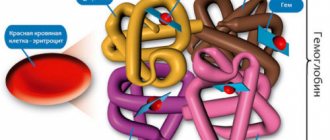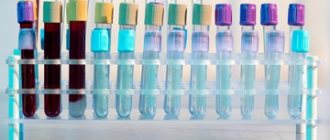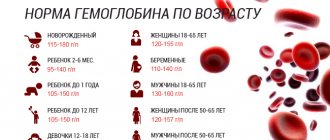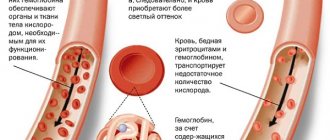What does the level of globulin in the blood affect?
Globulins are a group of proteins that help transport nutrients and fight infections. These are carrier proteins, enzymes, antibodies (immunoglobulins) and other fragments. Most globulins are produced by the liver, while others are produced by the immune system. Measuring levels will help diagnose whether there is an inflammatory disease or infection, as increased antibody production signals these disorders.
Symptoms of the disease:
- jaundice;
- nausea or vomiting;
- itching;
- periodic fatigue;
- accumulation of fluid in the body;
- loss of appetite.
Sometimes conditions are detected through routine testing before symptoms appear. If the readings are abnormal, further testing must be done to determine which specific protein is abnormally low or high. This is necessary to make an accurate diagnosis. Some examples of follow-up tests include: protein profile and quantitative immunoglobulins.
On a note! Your healthcare provider may order the test as part of a regular checkup or to diagnose certain conditions. Total protein measurements reflect nutritional status and can be used to screen for or diagnose kidney or liver disease.
general information
Gamma globulins perform different functions and have a very complex structure. One cell can divide into several factions. These cells move slower than others. They contain enzymatically active antibodies. They eliminate the influence of various viruses and bacteria on the body. The main gamma globulins are immunoglobulins. They stimulate the functioning of humoral immunity.
But usually the concentration of proteins in plasma is at the same level. If the content of gamma globulins increases, then the level of albumins and other cells decreases.
Determination of gamma globulin level is carried out:
- If a serious pathology is suspected.
- For diagnosing cancer.
- In the presence of acute infections or inflammations.
If the level of these cells deviates from the norm, then the diagnosis is easier to make, since the search circle is narrowed.
Analysis for gamma globulins also helps to select the correct course of treatment and subsequently monitor its effectiveness. Therefore, such a study is prescribed very often.
Throughout life, the composition of gamma globulin particles undergoes changes. This is influenced by chronic diseases and the characteristics of the human immune system.
Proteinogram
This is a laboratory test that is commonly used to identify patients with multiple myeloma or other serum protein disorders. Physicians include a proteinogram in the initial evaluation of numerous clinical conditions. However, sometimes the results of this test can be confusing or difficult to interpret.
List of diseases for which a proteinogram study is prescribed:
- allergies;
- autoimmune diseases such as lupus or rheumatoid arthritis;
- multiple myeloma, a type of cancer.
The nature of the results of whey protein electrophoresis depends on the fractions of two main types of protein: albumin and globulins. The main components of serum, they are produced by the liver under normal physiological conditions. Globulins make up a much smaller proportion of the total whey protein content. The subsets of these proteins and their relative abundance are the primary goal of proteinogram interpretation.
Five factions
In the blood, globulins are found in the form of five fractions: alpha-1 (α1), alpha-2 (α2), beta-1 (β1), beta-2 (β2), gamma (γ). But due to the lack of specific clinical significance, most often beta-1 and 2 globulins are not separated, so they usually mean simply the beta-fraction of globulins without distinguishing them.
It often happens that the total protein in the blood plasma is normal, but the proportions of protein fractions change. Thanks to such changes, it is possible to determine disturbances in the body’s functioning and the effectiveness of therapy.
Elevated alpha-1-globulins occur quite often.
What are globulins
Globulins (a group of proteins) are produced in the liver by the immune system. They play an important role in the functioning of the liver, blood clotting, and fighting infection. There are four main types of globulins. They are called alpha, beta and gamma. There are different types of tests to determine their quantity.
These include:
- Total protein analysis. This test measures two types of proteins: globulin and albumin. If protein levels are low, it may indicate liver or kidney disease.
- Serum protein electrophoresis. This test determines the amount of gamma globulin. It is used to diagnose immune system disorders and cancer called multiple myeloma.
Globulins exist in different sizes. The lightest are the alpha globulins, which typically have a molecular weight of about 93 kDa, while the heaviest class are the gamma globulins, which weigh about 1193 kDa. Being the heaviest, gamma globulins are the slowest to separate by gel electrophoresis.
Alpha globulins
These are blood proteins that are produced in the liver and perform several functions in the body. There are two types of alpha globulins: alpha 1 and alpha 2. They differ very little in structure, but perform the same functions. Their work includes transporting hormones, cholesterol and copper through the bloodstream, as well as acting as an enzyme for certain chemical reactions. They help or prevent the action of other enzymes, such as those that cause blood to clot.
Beta globulins
There are beta 1 and beta 2 globulins. They are very similar to alpha globulins in that they are also produced in the liver and have a similar structure. The structure is so similar that beta globulins have similar functions. They carry lipids, hormones and cholesterol through the bloodstream. Beta globulins help immune cells mount a defense in response to bacteria, viruses or parasites. If alpha 1 globulins are low, this may be a sign of antitrypsin deficiency.
Gamma globulins
These are blood proteins produced by lymphocytes and plasma cells of the immune system when an immune response is needed. These are known as immunoglobulins or antibodies, which help with immune responses and immunity. There are three main types of gamma globulins: IgM, IgG and IgA. These immunoglobulins are produced in varying amounts when needed to fight bacteria, viruses or toxins.
IgM
The largest of the immunoglobulins. Produced when certain bacteria, viruses, or other antigens enter the body. This helps initiate an immune response to fight invading bacteria and viruses. IgM is produced by plasma cells in the spleen and lymph nodes and circulates through the blood.
IgG
The most numerous of the immunoglobulins. It is also produced by plasma cells. IgG functions to help the immune system identify invading bacteria, viruses, or fungi. They help with the cascade of steps needed to fully formulate a countermeasure.
When toxins enter the body, IgG binds to them to help neutralize the toxins so they do not cause toxic effects. This particular immunoglobulin is found in every body fluid, indicating its importance.
When is the study scheduled?
It should be said right away that during an initial visit to any doctor, for example, a therapist, tests are first taken for total protein and protein fractions so that the doctor can get an approximate idea of the processes occurring with proteins in the body. A test for any haptoglobin or ceruloplasmin is never immediately prescribed. Of course, there are exceptions when the patient’s clinical picture is extremely characteristic of some disease (there are pathognomonic symptoms), when it is necessary to study these particular proteins.
So, in case of anemia, the doctor will be interested in transferrin, and in case of Wilson-Konovalov disease, copper metabolism is impaired, and it is important to know the level of ceruloplasmin. But if the doctor suspects some kind of infectious-allergic lesion, then it is necessary to look at many indicators at once.
Therefore, protein fractions are most often prescribed for various inflammatory diseases, including internal organs and the musculoskeletal system (gastritis, rheumatism) for various acute and chronic infectious diseases, for example, chronic brucellosis and Lyme disease, and rheumatic diseases, so-called collagenoses. These are systemic lupus erythematosus, scleroderma, rheumatoid arthritis, and so on.
The assessment of protein metabolism is very important in the diagnosis of malignant neoplasms. Finally, nutritionists and gastroenterologists prescribe a study of protein fractions in general and globulins in particular if they suspect malabsorption syndrome, or insufficient absorption, as well as with nutritional dystrophy, eating disorders and similar conditions.
How to properly prepare for analysis
No special preparation is required before taking the test. If your doctor orders additional blood tests, you may need to fast for several hours before the test. Check with your healthcare professional to see if there are any special instructions to follow if you are taking medications.
Globulin tests are blood tests. During the test, a medical professional takes material from a vein in the arm using a small needle. Once the needle is inserted, a small amount of blood will be collected in a tube or vial. You may feel a slight burning sensation as the needle enters or exits. The procedure usually takes less than five minutes. In infants or young children, a lancet is used to pierce the skin and the blood is collected in a glass pipette, test strip, or on a glass slide. A bandage may be placed over the area if there is bleeding.
Warning! There is little risk when taking the test. There may be some pain or bruising where the needle was inserted, but most symptoms go away quickly.
How to reduce its level?
A natural decrease in globulin concentration occurs against the background of diseases of the digestive system. The same effect will occur, for example, with gout, when the process of assimilation of proteins by the body is disrupted. How else can you lower your globulin level? The following tips will help:
- Nutrition. It is necessary to reduce the presence of protein foods in the diet, and increase those rich in carbohydrates. But at the same time, you need to increase physical activity, as well as the amount of fluid you drink daily.
- Traditional methods. Decoctions rich in vitamins C and B-group will help slow down the absorption of proteins. A decoction of rose hips is best suited for this. To prepare it you will need 100 grams of dried berries. They are soaked in cold water for an hour, then filtered, poured with 2 liters of water and cooked over low heat for 60 minutes. Afterwards, let it cool. Take 150 milliliters 2 times a day, it is recommended to also eat 20 - 30 grams of prunes. This remedy also helps normalize stool and prevent gastrointestinal diseases.
- Medicines. To quickly reduce globulin, doctors usually prescribe glucose drips.
For 8 more foods to reduce total protein in the blood, see a separate article.
Blood globulin level: table
Globulin in the normal range means a normal balance of carrier proteins, enzymes and antibodies that are essential for many biological processes. It also determines that there is no viral infection, inflammatory or immune disorder. The normal range is 2.0-3.9 g/dL in adults. The children's figure is slightly lower. If the total protein is abnormal, additional tests must be performed to determine which specific protein is low or high before a diagnosis can be made.
| Age | Male indicator (g/dl) | Female indicator (g/dl) |
| Children <6 months | 1,3-2,4 | 1,3-2,1 |
| Children 6-11 months | 1,7-3,0 | 1,2-2,4 |
| from 1 year to 19 years | 2,1-3,5 | 2,0-3,8 |
| >20 | 1,9-3,7 | 1,9-3,7 |
| AG coefficient | 1,0-2,5 | 1,0-2,5 |
Note! Each laboratory has a slightly different range of what is considered normal. Because of this, the doctor will consider your overall health and past tests when prescribing treatment.
Dosage and instructions for use
The drug is administered intramuscularly into the upper outer quadrant of the gluteal muscle or into the thigh, the outer surface. When administered, the operating rules are always followed: if the ampoule was stored in the refrigerator, it must be kept at room temperature for 2 hours. When opening, it is necessary to strictly follow all antiseptic rules, and in order to avoid the formation of foam, it must be collected with a needle with a wide bore.
A previously opened and unused ampoule must be disposed of, and a drug with a changed color, sediment or expired expiration date must also be disposed of. The dosage of gamma globulin depends on the doctor's prescription.
Prevention of hepatitis A:
- children 1-6 years old – 0.75 ml;
- up to 10 years – 1.5 ml;
- from 10 years and adults – 3 ml.
Prevention and treatment of influenza:
- children under 2 years old – 1.5 ml;
- from 2 to 7 years – 3 ml;
- from 7 years and adults – 4.5-6 ml.
Prevention of measles:
- once from 3 months, not sick and not vaccinated;
- no later than 6 days after contact with the patient;
- dosage 1.5 – 3 ml.
Prevention of whooping cough:
- once with an interval of 24 hours, 3 ml for children who have not been sick and have not been vaccinated;
- no later than 3 days after contact with the patient;
- dosage 1.5 – 3 ml.
Prevention of polio:
- once 3-6 ml for unvaccinated children and after contact with a sick person.
On a note! It is strictly forbidden to administer the drug intravenously. It is administered only as directed by a doctor and is not used together with calcium gluconate.
The administration of the drug is recorded in special accounting forms, which indicate the batch number, date, expiration date and the name of the manufacturer, dose and nature of the reaction.
Contraindications for use
Before prescribing, the doctor will definitely check the patient for the presence of various diseases that may appear when plasma protein is administered:
- allergic reactions;
- systemic immunopathological blood diseases;
- nephritis.
After administration, in order to avoid a reaction to the immunoglobulin drug, you need to take any antihistamine and continue taking it for 2-3 days. This will help eliminate allergies. If the patient has various immunopathological diseases already diagnosed by the doctor, in this case the drug is administered against the background of appropriate therapy. Its interaction with other drugs has not yet been studied and there is no data or incompatibility.
special instructions
Preparations based on human gammaglobulin are used only as prescribed by a doctor. After administration of the medicine, vaccinations against measles and mumps are carried out no earlier than 3 months later. Also, after vaccination, it is administered no earlier than 2 weeks, and if it is necessary to use the drug earlier than this period, vaccination is repeated. All other vaccinations can be done at any time, regardless of the date of administration of the serum.
What are the features of the AG coefficient
The main proteins present in serum are albumin and globulin. Albumin makes up more than 50% of all whey proteins. The hypertension ratio is used as an indicator of the disease state, but it is not a specific marker of the disease, since it does not indicate which proteins are changed. The normal AG ratio is 0.8-2.0. The ratio may be lowered in response to low albumin levels or increased globulins. General indicators may be increased in some chronic inflammatory diseases (tuberculosis, syphilis), multiple myeloma and rheumatoid arthritis. Values decrease in liver dysfunction, kidney disease and various neoplasms.
The AG ratio is a test to measure the value of total protein found in the blood, giving specific information about the amount of albumin and globulin and the ratio between them. The test is part of a routine health check along with other tests.
Warning! A high AG ratio may indicate a genetic deficiency or leukemia. Be sure to discuss your results with your doctor. Follow-up testing may be required.
How to increase its level?
A component of globulin is amino acids formed from proteins. Accordingly, the presence in the diet of foods that increase total protein in the blood must be increased.
Globulin is produced mainly in liver cells. Therefore, it will also be necessary to normalize the work of this body.
In total, the following recommendations will help increase the level of globulin in the blood:
- Nutrition. You will need to include cottage cheese, meat, chicken or quail eggs, soy, seafood, peanuts, and legumes in your diet. At the same time, it is necessary to minimize the consumption of foods rich in carbohydrates (sweets).
- Traditional methods. The most effective is an immortelle decoction - such a remedy comprehensively improves liver function, prevents the destruction of organ cells and their oxidation. The decoction is prepared as follows: for 1 liter of water, 2 tablespoons of dry plant base, cook for 15 minutes, leave until cool. Take 50 milliliters 2 times a day after meals. The course of treatment is up to 14 days, then a break of at least 10 days. The decoction tastes quite nasty (very bitter), so it can be mixed with honey or fructose-based syrup, but you should not add more than 3 tablespoons per 1 liter of decoction, since the amount of carbohydrates consumed should be reduced.
- Medicines. Complex vitamins (such as “Alphabet”) and hepatoprotectors that protect liver cells from oxidation (“Essentiale”) help best. Before using drug therapy, you should definitely consult with your physician.
The liver can produce only about 10 grams of globulin daily. And even if the entire diet consists of protein foods, this will not help speed up protein production. Therefore, the diet should still remain varied, including fats, carbohydrates, and fiber.
Causes of increased and decreased globulin
If globulins are elevated, this indicates infection, inflammatory diseases or impaired immunity. Elevated readings may also indicate certain types of cancer. Low levels are associated with liver or kidney disease. However, abnormal results are sometimes caused by certain medications, dehydration, or other factors. To find out what the results mean, talk to your doctor.
The most common cause of high levels is:
- Viral or bacterial infections.
- Dehydration.
- Liver diseases.
- Cancer: Hodgkin's lymphoma or multiple myeloma.
- Drugs such as amiodarone are used to treat or prevent heart palpitations.
Symptoms of a high rate:
- inflammation.
The most common cause of low levels is:
- Congenital immunodeficiency.
- Oxidative stress.
- Kidney disease (nephrotic syndrome).
- Malnutrition or lack of nutrients in the diet causes the value to decrease.
- Liver dysfunction.
- Acromegaly, a disorder that occurs as a result of excess growth hormone.
- Lungs' cancer.
Symptoms of a low score include:
- fluid accumulation (edema);
- susceptibility to infectious diseases;
- symptoms of liver dysfunction, jaundice, nausea, vomiting, fatigue and fluid accumulation.
The meaning of the norm, reasons for high content
The number of alpha-1 globulins normally ranges from 3 to 6%, that is, from 1 to 3 grams per liter. Alpha-1 globulins include:
- antichymotrypsin alpha-1;
- alpha-1 lipoprotein;
- fetoprotein alpha-1;
- antitrypsin alpha-1;
- alpha-1 glycoprotein.
These substances are also called acute phase proteins: their production occurs in increased quantities during various types of organ disorders (physical or chemical), during bacterial and viral infections. Thanks to them, tissue damage stops in the future, pathogenic microorganisms cannot multiply.
Alpha-1-globulin may be elevated when:
- bacterial and viral infection;
- chronic and acute inflammation;
- skin damage (trauma, burn);
- malignant tumors;
- changes in hormonal levels (pregnancy, steroid treatment);
- poisoning;
- systemic lupus erythematosus;
- arthritis;
- elevated body temperature;
- malformations of the baby in the womb or his death;
- multiple pregnancy.
The concentration of alpha-1 globulins decreases when the function of:
- liver (cancer, cirrhosis);
- kidneys (nephrotic syndrome);
- lungs (emphysema);
- testicles (oncology) or tumors of other organs.
Diagnostics
Protein levels show fairly predictable changes in response to acute inflammation, malignancy, trauma, necrosis, infarction, burns, and chemical injury. Medical examinations and tests are needed to determine whether globulin levels are normal and what may be causing them to be lower or higher than normal. To avoid any potential dangers, taking medications and lifestyle changes will bring the globulin levels back to the normal stage.
Tests can be used to help diagnose a variety of conditions:
- Liver damage.
- Kidney disease.
- Nutrition problems.
- Autoimmune disorders.
- Some types of cancer.
Testing for albumin and sex hormone binding globulin levels is performed to assess a person's existing hormone balance. The SHBG test is used to evaluate men with low testosterone levels and women with excess production. It is prescribed in combination with other tests to assess the state of a person's sex hormones. SHBG transports hormones in the blood in the form of biologically inactive forms. Changes in SHBG levels can affect the amount of the hormone available for use by body tissues.
Deviations from the norm and possible pathologies
If after the studies it is determined that the amount of globulins deviates from the norm in any direction, the doctor will prescribe additional diagnostics. Indicators of substances in the blood, as well as other factors, will indicate a particular disease. Each fraction has its own pathological processes.
Alpha globulins are produced by hepatocytes. Their increase in plasma may indicate allergic reactions. In addition, there are other ailments in which the level of α-globulins increases:
- tuberculosis;
- necrotic tissue damage;
- infections of any kind;
- damage to the epithelial layer;
- joint inflammation;
- malignant formations;
- taking male sex hormones.
- kidney diseases.
Tuberculosis is a disease in which globulin is increased.
Deviations of the level of α-globulins from the norm to a lesser extent occur with respiratory failure and intravascular hemolysis.
An increase in the level of β-globulins in the blood often occurs in women during pregnancy, especially when taking steroid hormones - estrogens. A similar situation can also occur when:
- malignant neoplasms:
- advanced tuberculosis;
- infectious hepatitis;
- obstructive jaundice;
- anemia.
Often, an increase in beta globulins is associated with impaired fat metabolism and problems with the cardiovascular system.
A decrease in the amount of beta globulins in the blood occurs for the following reasons:
- inflammation in the body;
- cancer;
- liver disease;
- eating small amounts of protein;
- increase in hormone levels;
- disturbances in the functioning of the pituitary gland;
- imbalance of the endocrine system.
Gamma globulins increase in almost chronic inflammatory processes, which are localized in the joints, gall and bladder, as well as in the renal pelvis. In addition, the reason for the jump in γ-globulins occurs as a result of:
- toxic damage to liver cells or;
- biliary dyskinesia;
- advanced pulmonary tuberculosis;
- diseases of the pulmonary system;
- AIDS.
A decrease in the amount of γ-globulins in the blood plasma is observed in the case of the development of acquired hypogammaglobulinemia, which develops with the following ailments:
- HIV infections;
- malignant tumor processes;
- protracted infectious processes and purulent inflammations;
- lack of protein in childhood due to poor nutrition;
In addition, a decrease in the amount of γ-globulins can be diagnosed during pregnancy and when taking glucocorticoids.











